How Does It Work?
Low frequency vibrations are used as a carrier to deliver high amplitude energy to a metal fabrication, or machined part. The heavy vibrations produce a load that is superimposed on the existing stress patterns that result in a reduction of peak residual stresses. This produces a more dimensionally stable product and reduces the random distortion that often occurs in unstable workpieces.
Are Resonant Vibrations Effective?
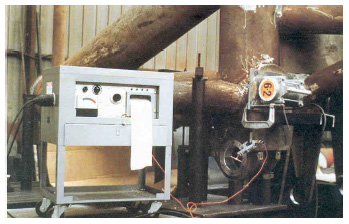
Resonant vibrations have been found to be the most effective means for reducing residual stresses by vibration. The resonant frequency vibration method has a much more pronounced stress redistribution compared to the subresonant (subharmonie) frequency methods. High amplitude resonant vibrations are very efficient in significantly reducing peak residual stresses in weldments.
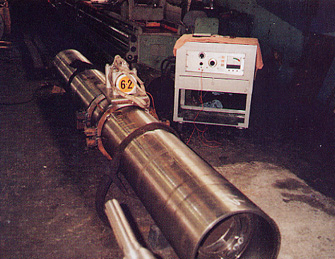
Are There Any Limitations?
There are some limitations as with any metalworking process. The process is not recommended for extrusions or severely cold worked items. On very large, very long or open space frame type structures, the vibration may need to be applied at several locations, which does require more time. Very small items in large quantities are more easily treated thermally in batches. In welding situations where vibration is used during the welding process, this method is most compatible with SMAW, GMAW and GTAW welding processes. Other welding practices may present formidable logistical problems.
What Can I Use It On?
The process can be used on a wide range of ferrous and non-ferrous metals. Typical materials are: carbon steels, stainless steel, aluminium, cast iron, manganese, incolnel, etc. these are a few of the metals that can be treated in a variety of conditions such as: wrought or cast, forged, formed, welded, ground, polished or machined.
How Do You Know When It's Done?
As with any treatment process, one must follow a recipe to achieve success. In a thermal process, treatments are governed
by a practice that dictates so many degrees per hour per inch of thickness. In the vibratory or non-thermal mode, the treatment is predicated on a time vs. weight basis where the aggregate weight of the part, including any associated tooling or fixturing attached to the part, is used to determine the length of time or treatment after resonance has been determined.
When Can I Stress Relieve A Part?
Parts may be stress relieved virtually at any point in the manufacturing process where the part is accessible. The most typical applications allow for stress relief at key junctures in the manufacturing process, i.e. after rough machining, boring, grinding, etc. For welded fabrications, stress relieving can be performed during welding which is very helpful in preventing residual stress build-up that can cause weld cracking or distortion of some sections.
Because the fusion process produces large temperature gradients in a short period of time, residual stresses are more dynamically active which can require stress relief during welding, immediately after welding or in an ongoing program of routine stress relief on a daily basis. As the time to completion increases for a fabrication, so does the risk of distortion related problems. Since large magnitude tensile residual stresses can reduce the fatigue life of welded assemblies, ample thought should be given to stress relieving all welded assemblies.
How Long Does It Take?
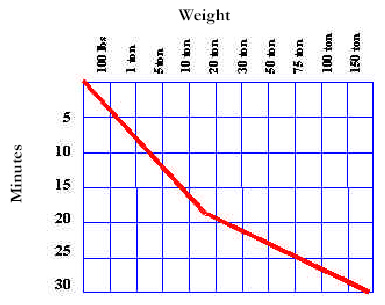
The actual length of time for treatment is based on weight per each application. Treatment time can range from a short fifteen minute period to an hour or more depending on the size of the item an whether or not it needs to be treated at more than one location.
How Can I Tell When Stresses Have Been Reduced?
The most direct way, and the most rewarding, is to resolve a basic dimensional instability problem. This is quite apparent when standard measurements techniques confirm that the part is now holding dimensions that previously moved in random fashion. However, in most stress relief applications, there is no major dimensional problem to overcome and the part looks the same before and after treatment. What now? Is there any simple way to tell how well we've done? Unfortunately, no! There have been some very technically weak and scientifically unsupported methods promoted over the years that allegedly indicate when stress relief occurs. Some of these methods claim that motor current changes are a means to indicate when the part is relieved or that vibration frequencies change as the stiffness of the part changes due to less resistance from stress or the part undergoes a vibration frequency change from an unnatural mode to a natural mode. While we all would like to see some evidence of change, it just isn't that simple. Real quantitative proof of stress relief efficiency can be obtained for virtually any metal using the right analytical tools. Whether you are using heat, vibration or a cryogenic technique for stress relief, you should only rely on known and approved analytical methods for determining when stresses have been reduced. This is very important because, not only do we need to know the magnitude of the stress concentration, but we also need to know whether it is tensile or compressive. There is no simple tool or technique available that can supply all of these data requirements for a three dimensional object. Measurement techniques used by researchers are well known and we strongly support them. We highly recommend x-ray diffraction per ASTM E915-83, high speed hole drilling with strain gauges per ASTM E837-85 or for ferromagnetic materials, the Barkhausen Noise Analysis method, for making any kind of determination that stresses have
been reduced.
 |
Is It Difficult To Set Up And Use?
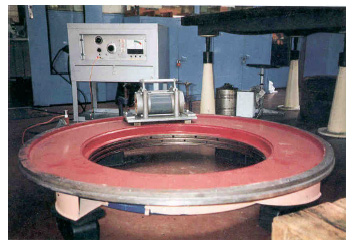
Not at all! There are a few rules that must be followed and they apply to all applications. The first requirement is to isolate the workpiece, as much as is practically possible, so it is free to vibrate. In cases where this is not possible, the vibration unit must be located as close as possible to the work area. The unit must be directly coupled to the workpiece in order to transfer the vibrational energy into the workpiece. This can be accomplished by using clamps, fasteners or adaptive fixtures. Once these conditions are met, the part must be vibrated for a minimum period of time based on weight. Parts can be vibrated for longer periods without suffering any fatigue damage or loss of tensile strength. The equipment is designed for ease of operation and is used both in shop environments and field applications by your personnel.
What Size Parts Can I Use It On?
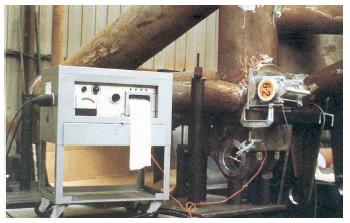
The “Formula 62” equipment can be used on a wide variety of shapes and sizes from small castings, shafts, gears, or OEM products to very large welded machined fabrications that are too large for thermal treatment. Using a special vibration table designed specifically to hold smaller parts, the vibration system can be set up right in the production area, which saves time and makes it possible to treat numerous parts at one time. The table has a capacity of 2000 lbs. Or 910 Kg., which makes it ideal for molds, die sets or other heavy workpieces.
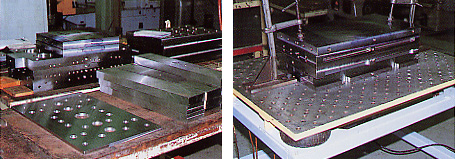
Can It Replace Thermal?
In cases where the thermal method is used solely to promote dimensional stability of the part for alignment purposes, surface integrity or service conditions, the vibration method can be used as a much more cost-effective replacement. This method also allows the machinist or fabricator to treat parts at various points throughout the manufacturing process that otherwise would be too costly or impossible to do, due to surface considerations. The thermal stress relief process, while adequate for many metals, does have some serious limitations that make vibratory stress relief a far better choice.
For example: AWS D1.1 does not recommend thermal treatment of A514, A517, A709 or Grade 100 material.
Other carbon or low alloy steels may undergo undesirable changes in microstructure, causing a deterioration of mechanical properties, cracking, or both. Additional consideration must be given to possible distortion, oxidation, loss of corrosion resistance or intergranular cracking that may result from the heat treatment. While the method is good, it's not perfect.
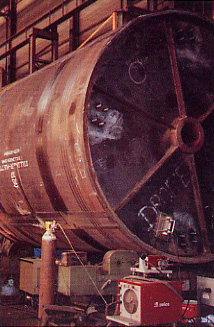 |
Vibrational Conditioning
Vibratory Stress Relief commonly called VSR or vibrational conditioning in it’s more generic form is typically used during and after welding to reduce distortion and enhance dimensional stability for machining purposes. It is now common practice to employ vibration during fabrication and machining throughout the metal working industry.
Is Vibratory Conditioning approved by code?
AWS does approve of the use of vibratory weld conditioning for welded joints, machinery, equipment, industrial cranes, and other material handling equipment.
For example:
AWS D14.1 Sec. 7.7 and AWS D14.4 Sec. 10.4 both specify vibratory conditioning to promote dimensional stability.
Vibratory Conditioning Sec. 7.7 and 10.4 state:
Vibrational conditioning of weldments to obtain dimensional stability for machining of welded structures may be employed with the approval of the Engineer. The conditioning shall be done in accordance with the recommendations of the manufacturer of the vibratory equipment. It shall not be substituted for thermal stress relief. |
Many code-required post weld heat treatments go beyond stress relief and can have a pronounced effect on the overall performance of the part. In cases where stress relief and changes in mechanical properties or metallurgical composition are needed, there can be no substitution.
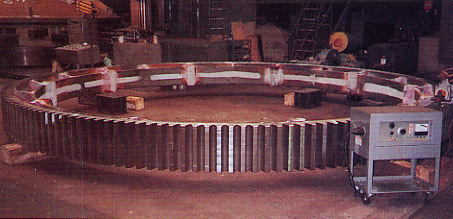
|








